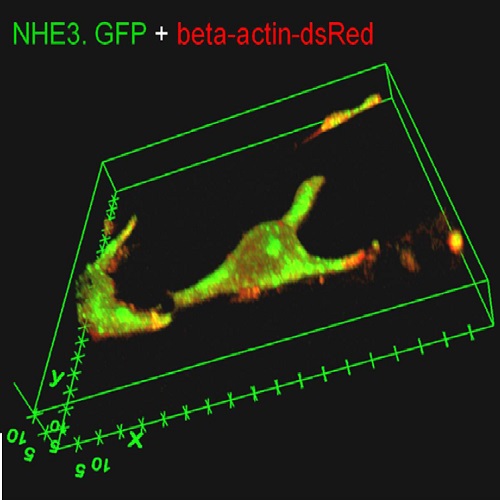Phospho-NHE3 forms membrane patches and interacts with beta-actin to sense and maintain constant direction during cell migration.
The Na(+)/H(+) exchanger NHE3 colocalizes with beta-actin at the leading edge of directionally migrating cells. Using human osteosarcoma cells (SaOS-2), rat osteoblasts (calvaria), and human embryonic kidney (HEK) cells, we identified a novel role for NHE3 via beta-actin in anode and cathode directed motility, during electrotaxis. NHE3 knockdown by RNAi revealed that NHE3 expression is required to achieve constant directionality and polarity in migrating cells. Phosphorylated NHE3 (pNHE3) and beta-actin complex formation was impaired by the NHE3 inhibitor S3226 (IC50 0.02µM). Fluorescence cross-correlation spectroscopy (FCCS) revealed that the molecular interactions between NHE3 and beta-actin in membrane protrusions increased 1.7-fold in the presence of a directional cue and decreased 3.3-fold in the presence of cytochalasin D. Data from flow cytometric analysis showed that membrane potential of cells (Vmem) decreases in directionally migrating, NHE3-deficient osteoblasts and osteosarcoma cells whereas only Vmem of wild type osteoblasts is affected during directional migration. These findings suggest that pNHE3 has a mechanical function via beta-actin that is dependent on its physiological activity and Vmem. Furthermore, phosphatidylinositol 3,4,5-trisphosphate (PIP3) levels increase while PIP2 remains stable when cells have persistent directionality. Both PI3 kinase (PI3K) and Akt expression levels change proportionally to NHE3 levels. Interestingly, however, the content of pNHE3 level does not change when PI3K/Akt is inhibited. Therefore, we conclude that NHE3 can act as a direction sensor for cells and that NHE3 phosphorylation in persistent directional cell migration does not involve PI3K/Akt during electrotaxis.

- Exp. Cell Res. 2014 May 15;324(1):13-29
- 2014
- Cell Biology
- 24657527
- PubMed
Enabled by:
